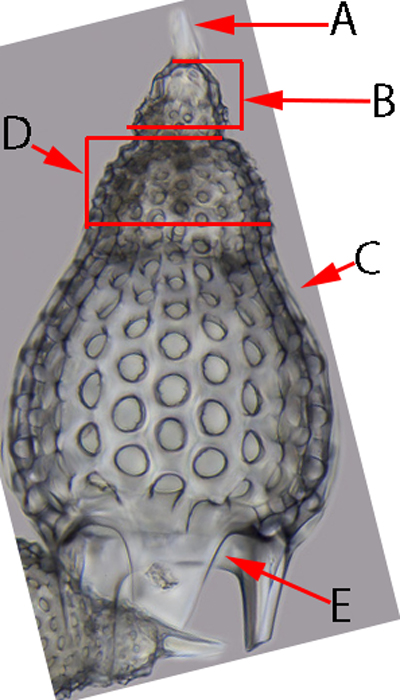The information get updated on this page at rapid intervals. No guarantee is given on the accuracy of the published data.
SILICOFLAGELLATES
Hard parts: Skeleton
Composition: Opaline silica
Morphology: Apical & basal rings, Spines and bars, Rods are hollow
Symmetry: Bilateral
Habitat: Planktic
Stratigraphic range: L. Cretaceous – Holocene
Sediments: Silicoflagellithite
Movement: Passive (plankton)
Notes: none
DIATOMS
Hard parts: Frustule
Composition: Organic silica
Morphology: Epitheca and hypotheca, Connective band(epicingulum)
Symmetry: Radial or bilateral (sometimes altered)
Habitat: Planktic and Benthic
Stratigraphic range: Jurassic – Holocene
Sediments: Diatomite
Movement: Movement on short distances (active)
Notes: Symmetry axes (pervalar, apical,transapical) images/diagrams
COCCOLITHOPHORIDS
Hard parts: Coccosphere
Composition: Calcium carbonate
Morphology: Coccoliths
Symmetry: Mostly radial (rarely bilateral or pentameral)
Habitat: Planktic
Stratigraphic range: Jurassic – Holocene
Sediments: Chalks and calcareous oozes
Movement: Passive (plankton)
Notes: images/diagrams
TASMANITIDS
Hard parts: Test
Composition: ?
Morphology: Wall with large pores
Symmetry: Spherical or radial
Habitat: Planktic
Stratigraphic range: Cambrian – Miocene
Sediments: Oil shales
Movement: Passive (plankton)
Notes: none
FORAMINIFERA
Hard parts: Test
Composition: calcitic, aragonitic, organic, siliceous, agglutinated
Morphology: Wall with very small microscopic voids
Symmetry: ?
Habitat: ?
Stratigraphic range: ?
Sediments: ?
Movement: ?
Notes: unicelluar organism
RADIOLARIANS
Generally planktonic and dwells in upper water column. Like people high on weed, they just passively migrated through floating. Soft parts of the organism are often protected by complex skeletons. They are super duper small; 30 microns to 2 millimeters. May be found in colonies (like gangsters of the micro world) in deep water situations. A dude named, Hackle came up with the first classification for these known as Hackel’s Plates.
Order ARCHEOSPICULARIA
Hard parts: spicules… also read notes
Composition: ?
Morphology:
Symmetry: Spherical but it becomes radial through evolution
Habitat: ?
Stratigraphic range: Middle Cambrian – Silurian ? Devonian
Sediments: ?
Movement: ?
Notes: Grow by adding each ring like section called sagital rings. The first ring is called cephalon, the second thorax and the rest is known as abdominal.
Order ALBAILLELLARIA
Hard parts: skeletons
Composition: ?
Morphology: skeletons with three intersecting bars
Symmetry: Bilateral
Habitat: ?
Stratigraphic range: ?Ordovician – Silurian throughout Permian – ?Early Triassic
Sediments: ?
Movement: ?
Notes: none
Order SPUMELLARIA
Hard parts: Test: porous capsule
Composition: ?
Morphology: Tangential: cortical, medulla and micro shells; Radial: principle and byspines
Symmetry: ellipsoidal, disc-shape, lenticular, latticed or spongy (spherical or radial ??-?-?-)
Habitat: ?
Stratigraphic range: Paleozoic – ?throughout Recent
Sediments: ?
Movement: ?
Notes: Solitary but sometimes (rare) colonial. Not to be confused with “sperm”…
Order NASSELLARIA

Refer to above image of Nassellaria;
A – Aperture; top/young
B – Cephalon
C – Thorax
D – Abdomen (Note all other additions comes AFTER thorax ring is classified as abdominal rings.)
E – Basal ring; bottom/adult
